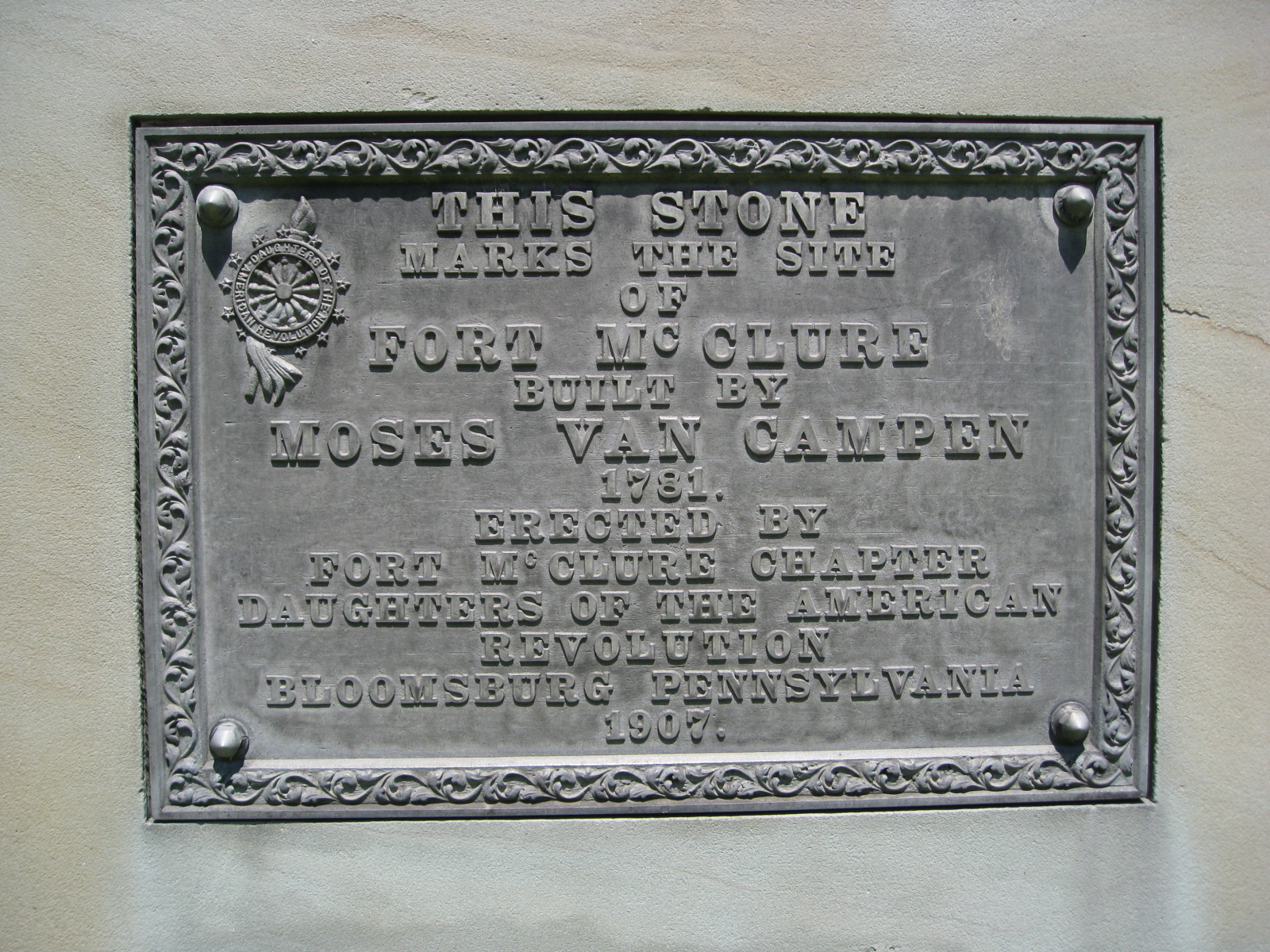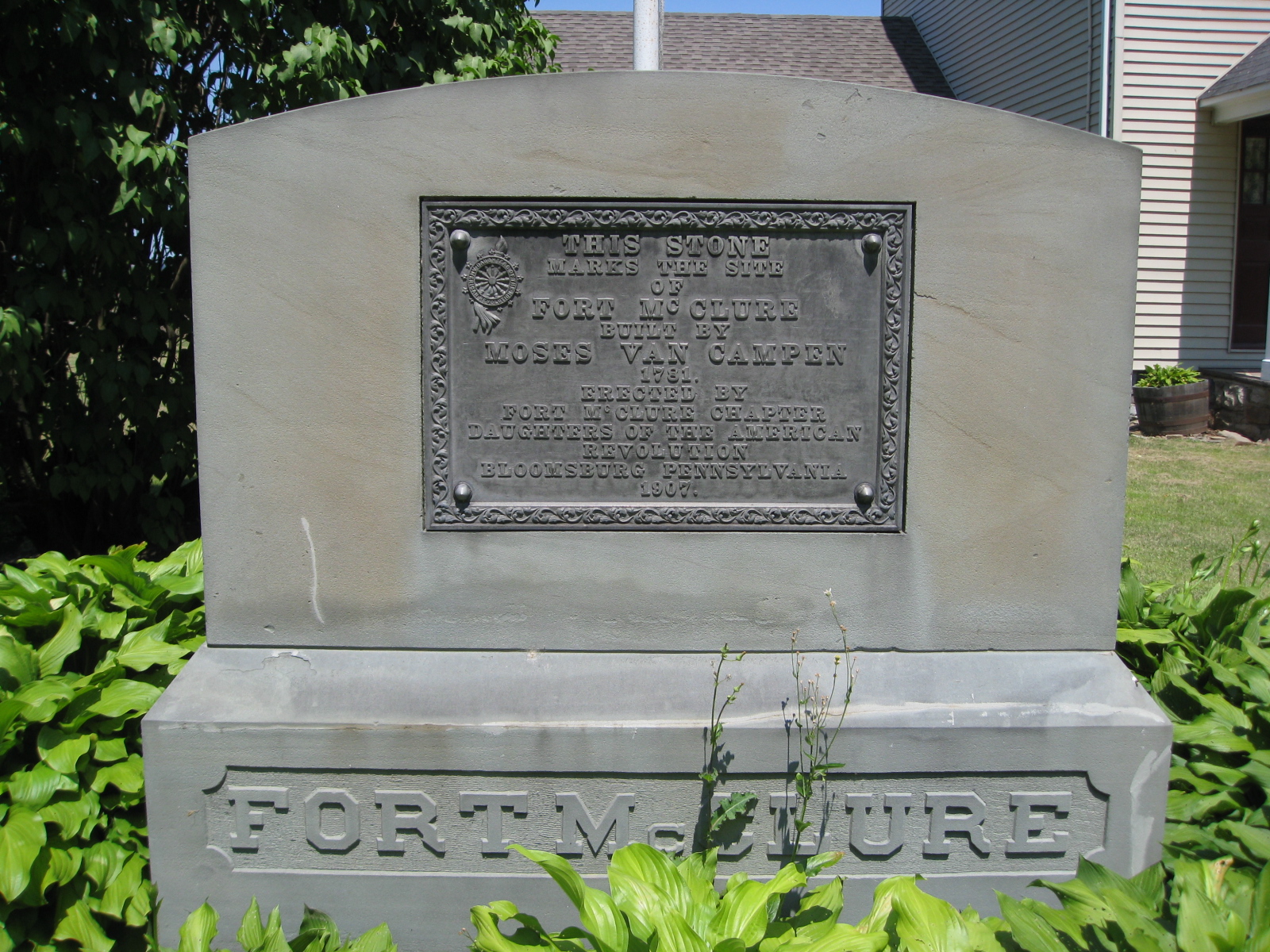Unveiled on April 10, 1907, the Fort McClure Chapter of the Daughters of the American Revolution (DAR), donated a stone marker and plaque commemorating the site of Fort McClure.

The plaque reads, "This stone marks the site of Fort McClure built by Moses Van Campen 1781. Erected by Fort McClure Chapter Daughters of the American Revolution Bloomsburg Pennsylvania 1907."
The following article appeared in the Janury, 1907 issue of Pennsylvania Magazine of History and Biography.
The Pennsylvania Magazine
of
History and Biography
The Historical Society of Pennsylvania
Vol. XXXI, January 1907
Fort McCLURE, Columbia County, Penna. Address made by Col. John G. Freeze, April 10th 1907, at the unveiling of the marker at the site of the old fort, Bloomsburg, Pa.—
We are standing to-day upon a spot of ground of which a careful writer has said: That looking up the Valley of the North East Branch of the Susquehanna you behold a scene spread out before you, which rivals in quiet beauty, the most famous landscapes in the country. There is not, in the distant profile of the Knob Mountain nor the less regular contour of the river hills that aspect of grandeur, presented by elevations of greater magnitude, but their proportions, and the general characteristics of the Valley they enclose, harmonize perfectly at that point in the eastern horiz-on where they seem to converge. The winding channel of the Fishing Creek for several miles from its mouth forms the foreground of this landscape view.
And you can very easily picture to yourselves the stirring times and anxious days and nights of the settlers in these wildernesses in the early clays, beautiful, romantic and well watered, it is no wonder that the white man and the red man strove for the mastery: and that the men on our side left to us a name for daring and courage which, after all these years, we are now commemorating.
So, also, the importance and the beauty of the locality are shown by the number of the Forts and the bloody raids which make up our history.
The broad valleys of the lower counties with their distant hills, do not impress us, as do the abrupt banks, the bare rocks, and the increasing roar of rushing waters in our mountain streams. These stir the blood, these call us to their distant sources, and we love the nooks and corners, the gnarled oaks and waving piues, that woo us to their shades and fill us with sweet odors.
Among the early settlers in and about what is now Bloomsburg we are more interested in the McClure family than in any other.
James McClure was a Lancaster County man and came here with a wife and family in 1772. He obtained a patent for his farm from the heirs of William Penn under the name of "McClure Choice."
The McClure tract was originally in the application of Francis Stewart, dated April 3, 1769, and is described as follows : "On the west side of the north east branch of the Susquehanna, near the mouth of Fishingcreek, adjoining land applied for by William Barton." The survey was made June 3, 1769, and contains 278 3/4 acres and is called " Beauchamp." The McClure Patent is dated November 6th, 1772.
Our Col. James McClure, who died upon this old homestead on October 4, 1850, was the youngest son of the original proprietor and was the first white child born in this section of Pennsylvania, his nativity being in 1774.
There were three Forts as they were called, being however stockades about the dwellings and outhouses of the owners and occupants. They were Fort Wheeler, Fort McClure and Fort Jenkins.
By the best evidence now available it seems that about the year 1778, Captain Salmon and Lieutenant Van Campen were sent by Col. Hunter to the mouth of Fishingcreek and up it, to select a place for fortification; and they selected the farm of a Mr. Wheeler located about where the Trench Paper Mill stands.
He had a pretty daughter named Annie and the Captain and his Lieutenant were suitors for her hand. The Captain won and a descendant of him and Annie was Sheriff of the County in 1834.
Van Campen returned to the McClure place, and Mrs. McClure having returned from Northumberland with her daughter Margaret, the Major built a stockade fort for the mother and laid seige to the heart of Margaret.
The building of McClure Fort was in 1781, and its location is well established. The monument is within the stockade: of that there can be no doubt. And we are therefore commemorating the very ground originally consecrated to the history of our people.
We cannot be certain whether any part of the present buildings are of the ancient construction: but the logs show that there were no saw mills in the vicinity, for the axe dressing points out and proves the antiquity of the timber and its use. So the stone in the foundation and wall do not carry the marks of the mason's hammer: most of them seem to be as they came from the river bottom.
The particular hero of the Town of Bloomsburg and vicinity is Major Moses Van Campen.
He was born in Hunterdon County, New Jersey, January 21, 1757. The family was from Holland. They came to Pennsylvania early and settled in Northampton County on the Delaware, above the Water Gap. In the course of time Moses got to Northumberland, and Mr. James McClure induced him to remain in the region and help the borderers. The Susquehannas were to be the battle ground and make heroes; and from that time to the end of the Border Indian War, Van Campen spent his time in the Forks of the Susquehanna.
On December 10, 1783, he married Miss Margaret McClure and took charge of the McClure farm and estate: shortly after he went to Briarcreek, and then in 1795 or 1796, the family moved to Allegany County, New York.
Mrs. Van Campen, our Margaret McClure, died at Dansville, New York, in March 1845, and the Major himself died on the 15th day of October, 1849, at the residence of his daughter Anna, at the age of 92 years and 9 months.
I have often thought, especially since gathering the material for this brief address, if we could have anticipated this day and occasion, how largely it would have added to our satisfaction, if we could have buried our hero and his beloved Margaret side by side, beneath this stone— inscribed with those beautiful lines of Collins:
How sleep the brave who sink to rest,
By all their country's wishes blessed!
When Spring, with dewy fingers cold,
Returns to deck their hallowed mould,
She there shall dress a sweeter sod
Than fancy's feet have ever trod.
By fairy hands their knell is rung;
By forms unseen their dirge is sung;
There honor comes a pilgrim grey,
To bless the turf that wraps their clay;
And freedom shall awhile repair,
To dwell a weeping hermit, there!
But though the bodies are absent the spirit and love of country which inspired them lives yet amongst us, and has been the moving cause which has here, on this sacred ground awakened our patriotism and erected solid and abiding testimonials to their memory and their worth.
Rest to their ashes wherever they be,
And peace to their spirits eternally.
